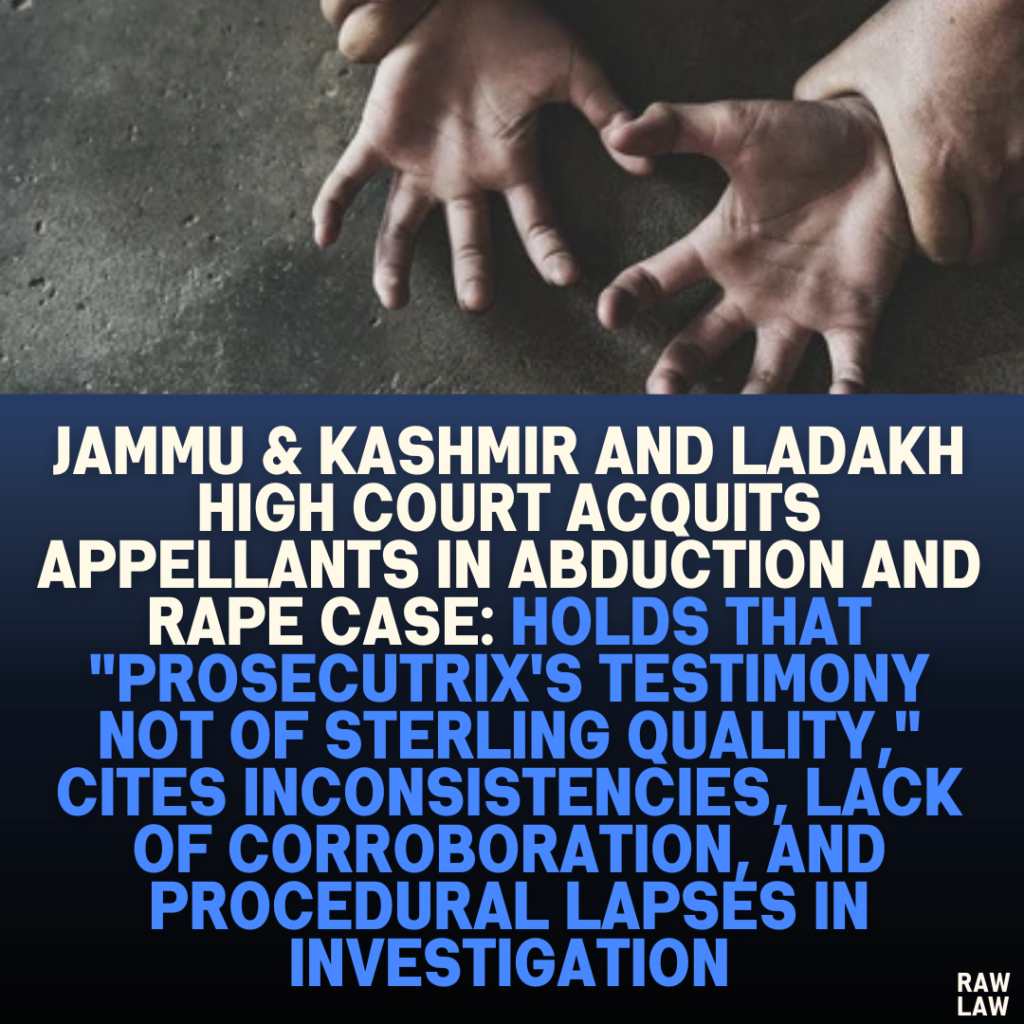Court’s Decision:
The High Court of Jammu & Kashmir and Ladakh overturned the trial court’s conviction of the appellants for charges under Sections 366 (kidnapping), 376 (rape), 344 (wrongful confinement), and 354 (assault with intent to outrage modesty) of the Ranbir Penal Code (RPC). The court found substantial inconsistencies in the prosecutrix’s testimony, lack of corroborative evidence, and procedural lapses in the investigation. The appellants were acquitted and their bail bonds discharged.
Facts:
- Incident Details:
- On February 13, 1997, the prosecutrix claimed she went to a neighbor’s house to borrow a frying pan. There, she was harassed by an individual who called neighbors and accused her of illicit conduct.
- Fleeing the situation, she encountered the appellants, who allegedly coerced her into an auto-rickshaw, blindfolded her, and took her to an undisclosed location where she was confined and raped.
- Confinement:
- She stated that she was confined in a dark room for 16 days and was repeatedly assaulted by one appellant while the other guarded the door.
- Release:
- On March 1, 1997, the prosecutrix claimed she was left at a lane near a shrine. She reported the incident to the police the same day, leading to the registration of an FIR.
- Trial Court Proceedings:
- The trial court convicted the appellants based on the prosecutrix’s testimony despite the lack of physical evidence or corroboration.
Issues:
- Was the testimony of the prosecutrix reliable and sufficient for conviction?
- Did the prosecution fail to corroborate the claims of the prosecutrix with additional evidence?
- Did the trial court err in evaluating the inconsistencies in the prosecution’s case?
Petitioner’s Arguments:
- The appellants contended that:
- The prosecutrix’s testimony was inconsistent and lacked credibility.
- The investigation was flawed, with the prosecution failing to identify the location of confinement or corroborate the prosecutrix’s account with witness testimonies or physical evidence.
- The medical evidence did not support the claims of injuries.
- Key witnesses, such as neighbors and the person from whom she allegedly fled, were not examined.
Respondent’s Arguments:
- The state argued:
- The testimony of the prosecutrix was sufficient for conviction.
- Minor inconsistencies in the victim’s testimony should not undermine the credibility of her claims, given the traumatic nature of the incident.
- The appellants’ conduct was corroborated by circumstantial evidence, such as the seizure of the prosecutrix’s clothing.
Analysis of the Law:
- Legal Standard for Prosecutrix’s Testimony:
- The court reiterated that the testimony of a prosecutrix can serve as the sole basis for conviction in sexual offence cases, provided it is of “sterling quality”—free of contradictions, consistent, and corroborated where necessary.
- Referring to precedents, the court emphasized:
- Rai Sandeep v. State (NCT of Delhi): A “sterling witness” must present a truthful and unassailable account, consistent with the prosecution’s case and other evidence.
- Nirmal Premkumar v. State: Testimonies in the “neither wholly reliable nor wholly unreliable” category require corroboration.
- Krishan Kumar Malik v. State of Haryana: A victim’s account must be consistent, reliable, and trustworthy to sustain a conviction.
- Inconsistencies in the Prosecutrix’s Testimony:
- Contradictions in Blindfolding:
- The prosecutrix initially claimed she was blindfolded during abduction and release. However, during cross-examination, she stated she was not blindfolded when released and could see her surroundings.
- The court noted this discrepancy undermined her claim of being unaware of the place of confinement.
- Medical Evidence:
- Although the prosecutrix claimed visible injuries, the medical certificate revealed no marks of violence, casting doubt on her testimony.
- Seizure of Clothes:
- The prosecutrix stated that her clothing was torn during the incident, but the seizure memo did not mention torn clothes, further weakening her account.
- Contradictions in Blindfolding:
- Lapses in Investigation:
- The investigating officer failed to:
- Identify the place of confinement despite the prosecutrix’s ability to see it during her release.
- Examine key witnesses, such as neighbors and the person she fled from.
- The investigating officer failed to:
Precedent Analysis:
- The court relied on decisions emphasizing the importance of consistency and corroboration in cases involving sexual offences:
- In Rai Sandeep, it was held that a prosecutrix’s account must withstand cross-examination and align with supporting evidence to be deemed credible.
- In Krishan Kumar Malik, it was clarified that the lack of corroboration can undermine a prosecutrix’s account if significant gaps and contradictions exist.
Court’s Reasoning:
- The court found the prosecutrix’s testimony inconsistent and lacking the reliability necessary for a conviction.
- Contradictions regarding the blindfolding and the location of confinement suggested her account was not truthful or complete.
- The absence of medical evidence supporting her claim of injuries further weakened the case.
- The prosecution’s failure to examine critical witnesses and corroborate the prosecutrix’s story highlighted significant investigative lapses.
Conclusion:
The court concluded that:
- The testimony of the prosecutrix was not of “sterling quality” and could not be relied upon for conviction.
- The trial court had erred in convicting the appellants without adequately addressing the contradictions and gaps in the evidence.
- The appellants were acquitted, and their bail bonds were discharged.
Implications:
- The judgment underscores the need for careful evaluation of prosecutrix testimony in sexual offence cases and emphasizes the importance of corroboration when inconsistencies arise.
- It highlights the judiciary’s role in safeguarding the rights of the accused while ensuring justice in sensitive cases.
